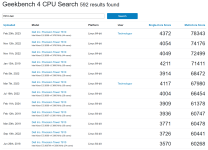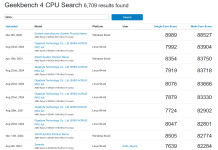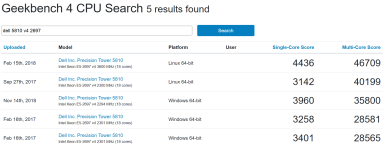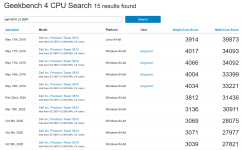Thanks for the measurements! Do you have one without the gate as well? Just to see the actual low end knee (which is wiped out by the 5 ms window here)
Now that I've spent ~50€ in electricity for ath, I finally found out that it's really easy to detect simulations with flipped faces with pixel detection through pyautogui. With that I can switch back to a deterministic solver and don't have to guess the "noise" of the bugged simulations.
Mabat, can you share some details on your proprietary algorithm? Or is it also such a hack that you'd rather not talk about it? 😀
Mabat, can you share some details on your proprietary algorithm? Or is it also such a hack that you'd rather not talk about it? 😀
I'm curious if anyone has used the R-OSSO curvature to create a waveguide / horn for a planar driver? I have some Heil ESS AMT's that I bought on a whim, and I previously 3D printed some tractrix horns that seemed to do something good for the frequency response. Could make for an interesting experiment.
Hi! I have just started out with Ath for doing some simulations and experiments. I seem to have been able to model a horn for a rectangular source (see config below). But I wonder, how can I model the driver as a dipole source (like open baffle)? I tried to search this great thread, but couldn't find the way...

Code:
ABEC.MeshFrequency = 1000
ABEC.NumFrequencies = 40
ABEC.Polars:SPL_H_ARRAY = {
FRDExport = {
NamePrefix = "array_hor"
}
MapAngleRange = -90,90,19
NormAngle = 0
}
ABEC.Polars:SPL_V_ARRAY = {
FRDExport = {
NamePrefix = "array_ver"
}
Inclination = 90
MapAngleRange = -90,90,19
NormAngle = 0
}
ABEC.SimType = 2
ABEC.f1 = 200
ABEC.f2 = 15000
Horn.Adapter = {
Height = 125
Segments = 0
Width = 37
}
Horn.Part:1 = {
H = {
a = 35
a0 = 0
k = 1
n = 4
q = 0.998
r0 = 18.5
s = 0.5
}
L = 1
Segments = 16
V = {
a = 0
a0 = 0
k = 1
n = 0
q = 0.998
r0 = 62.5
s = 0
}
ZMap = 0.5,0.3,0.5,0.9
}
HornGeometry = 2
Length = 111
Mesh.Enclosure = {
Spacing = 30
Depth = 24
EdgeRadius = 10
EdgeType = 1
FrontResolution = 10
BackResolution = 10
}
Mesh.AngularSegments = 64
Mesh.InterfaceOffset = 0
Mesh.InterfaceResolution = 6
Mesh.MouthResolution = 12
Mesh.RearResolution = 25
Mesh.SubdomainSlices = -2
Mesh.ThroatResolution = 6
Mesh.WallThickness = 10
Mesh.ZMapElementSize = 0.3,0.6,0.5,0.95
Output.ABECProject = 1
Output.STL = 1
Throat.Angle = 0
Throat.Diameter = 37Which driver is currently the "obvious choice no.1"? I was first planning to use BMS 5530ND but I'd like to have lower crossover point.CDX14-3055 + A520G2/36-EXT.
View attachment 1435413
If you can tolerate the HFs, this is well-usable even from 400 Hz. And honestly it sounds quite lovely. If this was a bit better up to ~15 kHz, this would be an obvious choice no.1.
Would DCX464 outperform normal drivers if cost and complexity were not an issue?
What kind of times are you guys seeing for your sims? What's the fastest system you've been able to cobble together?
At the moment, I am using Dell T5810s with 96-128GB of ECC DDR4 DRAM and 14 core Xeon E5 2697 v3s.
I'm toying with the idea of upgrading to E5 2698 v4s.
Basically, what I've noticed is that I'm hitting the wall on the thermal performance of my CPU. It looks like the maximum temperature is fairly low, just 76.8 degrees celsius / 170F. Where I live, it gets to 120F, so the temps ain't doing me any favors. My recent sims have been taking about seven hours or so, to solve a freestanding enclosure and waveguide with a throat resolution of 1.5mm and about 8000 elements. (Number of elements doesn't seem to have a dramatic impact on how long things take once you have gobs of ram; when I had 32GB, if I had too many elements, the simulation would just stall. Now it never fails, it just sometimes takes a third of a day to do one sim.) When running these seven hour long sims, I can see that nearly every core is hitting it's thermal limit of 76.8C. I tried upgrading the stock cooler and that was an epic fail, it nearly destroyed the case. (Stripped one of the CPU mounting threads, nearly making the entire case unusable.)
The E5 2698 v4 has 43% more cores and a max temp of 90C / 194F. It's also about 500% more expensive. (E5 2697 V3 are about $15, E5 2698 V4 is about $80. Original MSRP was $3226 lol.)
I keep toying with the idea of getting an AMD Threadripper or something like that, but it's still possible to assemble a forty core / eighty thread monster for under $500. (Dell T7810 with dual E5 2698s can be had for about that.)
So... Are you guys finding that tons and tons and tons of cores scales in Abec? Or should I get a modern CPU with faster RAM and a faster clock but a semi-sane number of cores, such as eight?
I'm kinda leaning toward the E5 2698 V4, because it drops right in, but if I have to bite the bullet and get me something new, it gives me an excuse to get a Nvidia 5060TI.
At the moment, I am using Dell T5810s with 96-128GB of ECC DDR4 DRAM and 14 core Xeon E5 2697 v3s.
I'm toying with the idea of upgrading to E5 2698 v4s.
Basically, what I've noticed is that I'm hitting the wall on the thermal performance of my CPU. It looks like the maximum temperature is fairly low, just 76.8 degrees celsius / 170F. Where I live, it gets to 120F, so the temps ain't doing me any favors. My recent sims have been taking about seven hours or so, to solve a freestanding enclosure and waveguide with a throat resolution of 1.5mm and about 8000 elements. (Number of elements doesn't seem to have a dramatic impact on how long things take once you have gobs of ram; when I had 32GB, if I had too many elements, the simulation would just stall. Now it never fails, it just sometimes takes a third of a day to do one sim.) When running these seven hour long sims, I can see that nearly every core is hitting it's thermal limit of 76.8C. I tried upgrading the stock cooler and that was an epic fail, it nearly destroyed the case. (Stripped one of the CPU mounting threads, nearly making the entire case unusable.)
The E5 2698 v4 has 43% more cores and a max temp of 90C / 194F. It's also about 500% more expensive. (E5 2697 V3 are about $15, E5 2698 V4 is about $80. Original MSRP was $3226 lol.)
I keep toying with the idea of getting an AMD Threadripper or something like that, but it's still possible to assemble a forty core / eighty thread monster for under $500. (Dell T7810 with dual E5 2698s can be had for about that.)
So... Are you guys finding that tons and tons and tons of cores scales in Abec? Or should I get a modern CPU with faster RAM and a faster clock but a semi-sane number of cores, such as eight?
I'm kinda leaning toward the E5 2698 V4, because it drops right in, but if I have to bite the bullet and get me something new, it gives me an excuse to get a Nvidia 5060TI.
I'm using a Ryzen 9 5950x because that still uses the AM4 socket and it was only ~300 bucks a few months ago. Should be about 2-3 times as fast as one E5 2697. My 1/4 symmetry sims only take 60-90 seconds, though.
I suggest you run the same config and reduce the resolution each time until you see a significant change in the results.
I suggest you run the same config and reduce the resolution each time until you see a significant change in the results.
Here's a quick illustration of how hard it is to beat those dumb eleven year old Dell T5810s.
I've attached a photo comparing the performance of various builds of the Dell T5820 and the Dell T7820 online. The T5820 is the dual socket version of the T5810, and the T7820 is the dual socket version of the Dell T7810, which was the follow up to the T5810.
In the attached photos, you can see that the T7810 and T7820 are only marginally faster than the T5810 and the T5820. A lot of this is because the Xeon E5 V4s aren't "technically" supposed to work in the T5810s and T5820s, but they drop right in, as I understand it. (All of my Xeons are V3 not V4.)
The V4 Xeons are a substantial improvement over the V3. So Intel basically made a big leap between Haswell-EP (Xeon V3, 2014) and Broadwell (Xeon V4, 2015.)
I've attached a photo comparing the performance of various builds of the Dell T5820 and the Dell T7820 online. The T5820 is the dual socket version of the T5810, and the T7820 is the dual socket version of the Dell T7810, which was the follow up to the T5810.
In the attached photos, you can see that the T7810 and T7820 are only marginally faster than the T5810 and the T5820. A lot of this is because the Xeon E5 V4s aren't "technically" supposed to work in the T5810s and T5820s, but they drop right in, as I understand it. (All of my Xeons are V3 not V4.)
The V4 Xeons are a substantial improvement over the V3. So Intel basically made a big leap between Haswell-EP (Xeon V3, 2014) and Broadwell (Xeon V4, 2015.)
Attachments
I'm using a Ryzen 9 5950x because that still uses the AM4 socket and it was only ~300 bucks a few months ago. Should be about 2-3 times as fast as one E5 2697. My 1/4 symmetry sims only take 60-90 seconds, though.
I suggest you run the same config and reduce the resolution each time until you see a significant change in the results.
Attached are some benchmarks on the Dell T5810 E5-2697 V3 ($15) vs the Dell T5810 E5-2697 V4 ($45) vs the AMD Ryzen 9 5950x ($250)
All prices are used
Attachments
Not to derail things too much, but will Windows 11 run on either of those?At the moment, I am using Dell T5810s with 96-128GB of ECC DDR4 DRAM and 14 core Xeon E5 2697 v3s.
I'm toying with the idea of upgrading to E5 2698 v4s.
1746 is a screw on diver, 1745 is the flange mount version of the same driver and would be easier to use in this case. I have been 3D printing adapters for screw on drivers because I happen to have a bunch of small format jbl ring radiator types to play with but flange mount drivers are much easier to experiment with. I have never heard the Celestion 1745 but people have said they sound very much like B&C de250. They don't seem to go very low so I don't think they would benefit from the large horn. An a400 or Tritonia would probably be great.Has anyone looked at the Celestion cdx1-1746 for a460 horn yet?
What are you guys simulating? I'm using my almost 10yo work laptop, I don't even know the processor or specs of it. Axisymmetric freestanding waveguides take perhaps 20 seconds or something, rather fast, fast enough. More elaborate models I've done takes perhaps few hours using quarter symmetry, or depending what the work is I could simplify further to reduce the time to get comparisons done. Yeah there is anomalies sometimes due to the mesh, but it's quite easy to see through them. I try to remember that for example midrange box with multiple domains, attempt to simulate passive cardioid box, band limited to perhaps 2k, takes only few minutes, certainly not hours. Perhaps dome tweeter waveguides need very high resolution, but those objects are relatively small. Never done these though.
I like the CDX1-1745 at lot. It's my daily listen...I have never heard the Celestion 1745 but people have said they sound very much like B&C de250.
https://www.stereonet.com/forums/to...ker-diy-seos-12-cdx1-1745-faital-pro-12pr300/
Don't quote me on this but I read something a while ago about it mostly being limited by memory speed and that having 3/4 threads per memory channel was the most efficient. This was related to other CFD and not specifically Akabak/Abec though.
It was suggesting using a duel CPU setup with less cores but more memory channels to get faster results.
I have been using an i7-10700k with 128gb of ram and generally run it using 15 threads which would be less than 4 per memory channel.
I haven't run any simulations for a while but I would be happy to run a set sim in Akabak to compare the time it took @Patrick Bateman
edit: I actually think I should use 8 threads rather than 15 as consumer CPU are generally duel channel but with two modules per channel if that is what it was referring to
It was suggesting using a duel CPU setup with less cores but more memory channels to get faster results.
I have been using an i7-10700k with 128gb of ram and generally run it using 15 threads which would be less than 4 per memory channel.
I haven't run any simulations for a while but I would be happy to run a set sim in Akabak to compare the time it took @Patrick Bateman
edit: I actually think I should use 8 threads rather than 15 as consumer CPU are generally duel channel but with two modules per channel if that is what it was referring to
I assembled couple months ago below wg and ob speaker. Wg is designed using athI'm curious if anyone has used the R-OSSO curvature to create a waveguide / horn for a planar driver? I have some Heil ESS AMT's that I bought on a whim, and I previously 3D printed some tractrix horns that seemed to do something good for the frequency response. Could make for an interesting experiment.
Yeah, I'm not telling you to switch. The 5950X was the best option for me because I already have an AM4 motherboard.Dell T5810 E5-2697 V3 ($15) vs the Dell T5810 E5-2697 V4 ($45) vs the AMD Ryzen 9 5950x ($250)
I'd get an Epyc 7532 if I had to change motherboards, but I wouldn't settle for older hardware since I burned through 200kWh in a month with a single desktop CPU.
https://www.cpubenchmark.net/cpu_value_alltime.html#multicpu_xy_scatter_graph
I like this graph to see the cheap outliers. 🙂
as others pointed out don't expect a crossover lower than 1.25 kHz LR24Has anyone looked at the Celestion cdx1-1746 for a460 horn yet?
- Home
- Loudspeakers
- Multi-Way
- Acoustic Horn Design – The Easy Way (Ath4)




